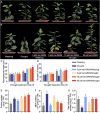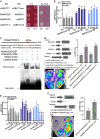Strigolactones enhance apple drought resistance via the MsABI5-MsSMXL1-MsNAC022 cascade
- PMID: 40395925
- PMCID: PMC12090352
- DOI: 10.1093/hr/uhaf101
Strigolactones enhance apple drought resistance via the MsABI5-MsSMXL1-MsNAC022 cascade
Abstract
Drought stress limits plant growth, development, and yield in apple (Malus). Strigolactones (SLs) work with abscisic acid (ABA) to improve drought resistance in plants, but how this synergistic mechanism functions remains unclear. Here, we determined that SLs promote drought resistance in apple in an ABSCISIC ACID INSENSITIVE5 (MsABI5)-related manner. During drought stress of a wild apple species (Malus sieversii), SLs enhanced the expression of MsABI5, encoding a major transcription factor involved in ABA signaling. MsABI5 bound to the promoter of the gene encoding delta-1-pyrroline-5-carboxylate synthase (MsP5CS2.2), upregulating its expression and thereby enhancing proline accumulation and drought resistance. In addition, MsABI5 suppressed the expression of MsSMXL1, encoding a major transcriptional repressor involved in SL signaling. MsSMXL1 interacted with MsNAC022 instead of MsABI5 to repress the transactivation activity of MsNAC022. MsNAC022 was upregulated by MsABI5, and MsNAC022 directly promoted MsP5CS2.2 expression to enhance proline accumulation and drought resistance. These findings suggest that MsSMXL1 and MsNAC022 comprise a regulatory node downstream of MsABI5 during drought stress in apple. Together, our findings suggest that in apple, SLs increase drought resistance by activating the MsABI5-MsSMXL1-MsNAC022 cascade.
© The Author(s) 2025. Published by Oxford University Press on behalf of Nanjing Agricultural University.
Conflict of interest statement
The authors declare that they have no conflict of interest.
Figures






Similar articles
-
miR164g-MsNAC022 acts as a novel module mediating drought response by transcriptional regulation of reactive oxygen species scavenging systems in apple.Hortic Res. 2022 Aug 30;9:uhac192. doi: 10.1093/hr/uhac192. eCollection 2022. Hortic Res. 2022. PMID: 36338839 Free PMC article.
-
MicroRNA156ab regulates apple plant growth and drought tolerance by targeting transcription factor MsSPL13.Plant Physiol. 2023 Jul 3;192(3):1836-1857. doi: 10.1093/plphys/kiad099. Plant Physiol. 2023. PMID: 36805285 Free PMC article.
-
MdbHLH160 is stabilized via reduced MdBT2-mediated degradation to promote MdSOD1 and MdDREB2A-like expression for apple drought tolerance.Plant Physiol. 2024 Jan 31;194(2):1181-1203. doi: 10.1093/plphys/kiad579. Plant Physiol. 2024. PMID: 37930306
-
MdCER2 conferred to wax accumulation and increased drought tolerance in plants.Plant Physiol Biochem. 2020 Apr;149:277-285. doi: 10.1016/j.plaphy.2020.02.013. Epub 2020 Feb 14. Plant Physiol Biochem. 2020. PMID: 32088579 Review.
-
Strigolactones can be a potential tool to fight environmental stresses in arid lands.Environ Res. 2023 Jul 15;229:115966. doi: 10.1016/j.envres.2023.115966. Epub 2023 Apr 24. Environ Res. 2023. PMID: 37100368 Review.
References
-
- Baker NR. Chlorophyll fluorescence: a probe of photosynthesis in vivo. Annu Rev Plant Biol. 2008;59:89–113 - PubMed
-
- Gilbert ME, Medina V. Drought adaptation mechanisms should guide experimental design. Trends Plant Sci. 2016;21:639–47 - PubMed
-
- Székely G, Abrahám E, Cséplo A. et al. Duplicated P5CS genes of Arabidopsis play distinct roles in stress regulation and developmental control of proline biosynthesis. Plant J. 2008;53:11–28 - PubMed
LinkOut - more resources
Full Text Sources

